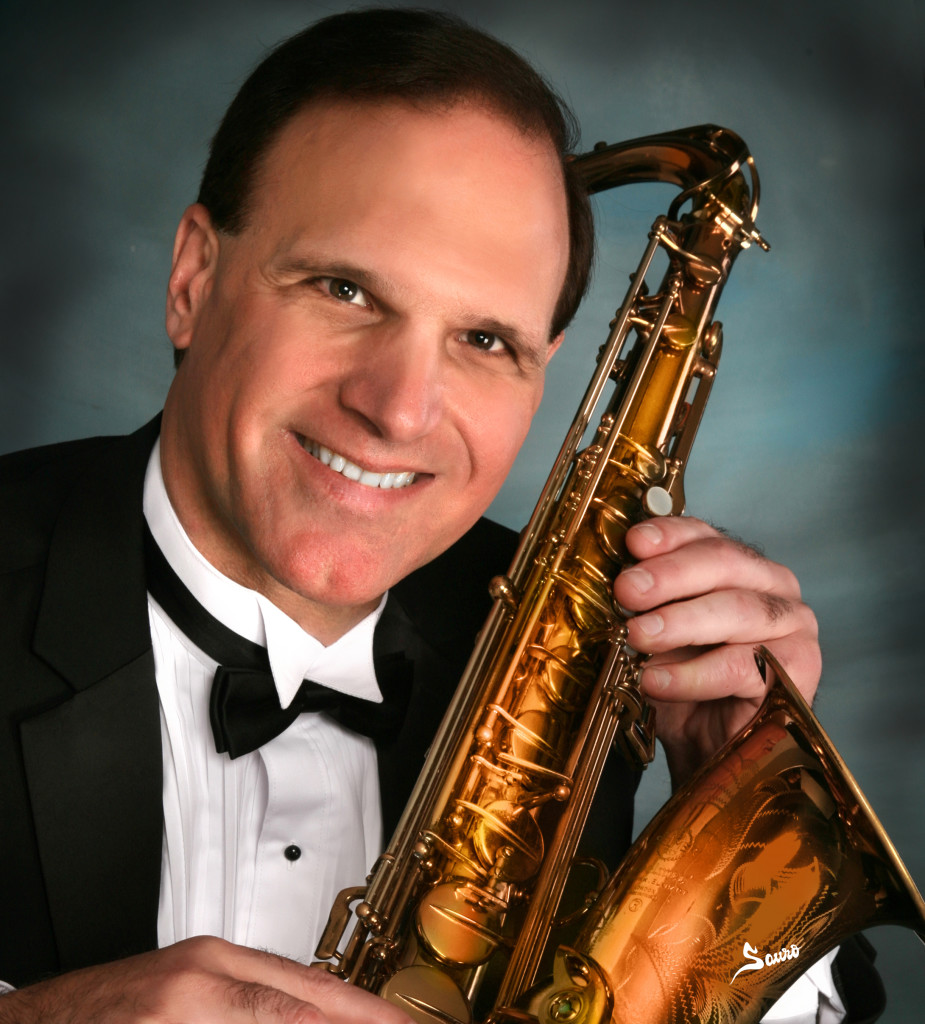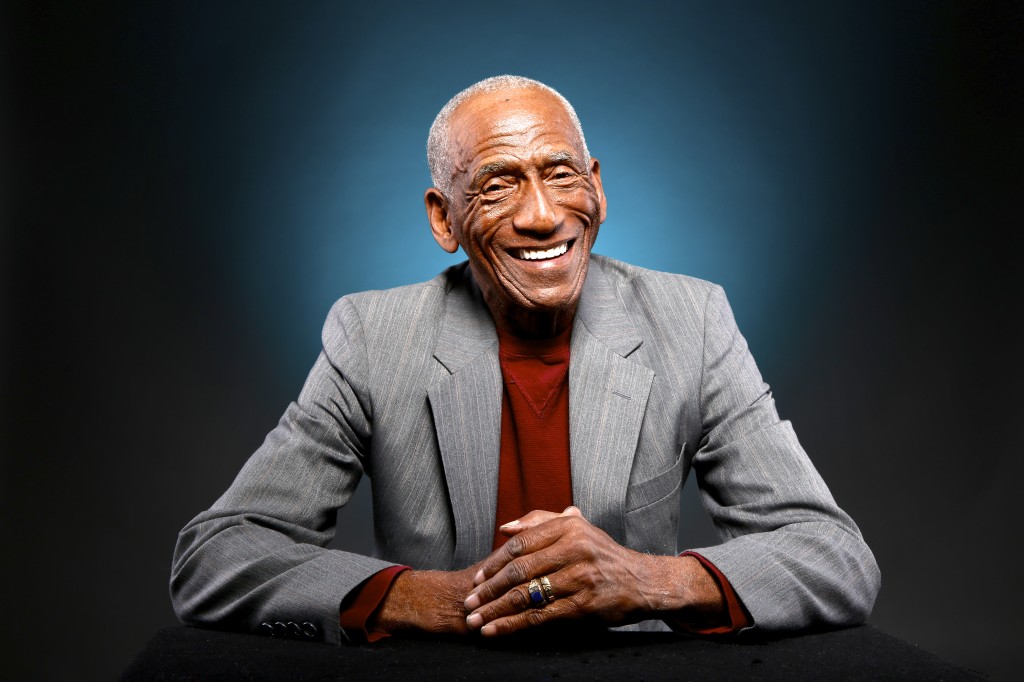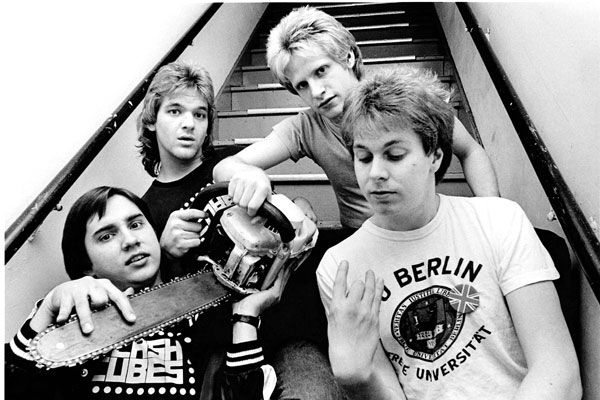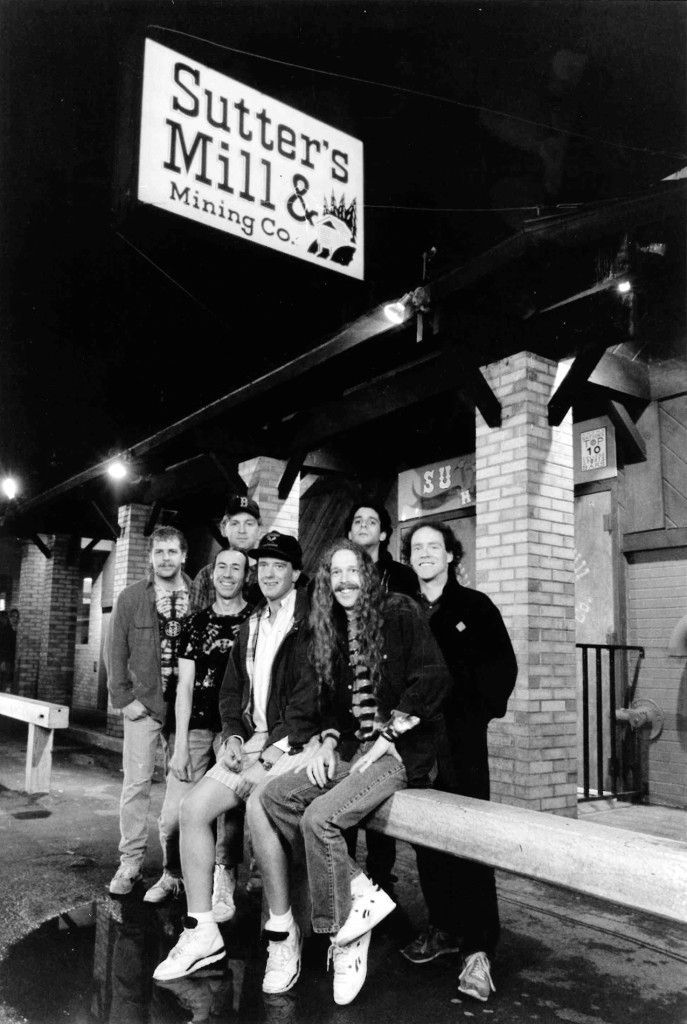Art Robins
Born in South Carolina as Art Robinson, he was brought north, and eventually to Syracuse, through music. He was introduced to singing in church when he was 13; by age 17, he was in a group in Pittsburgh, Pa., when he was discovered by a touring band in 1957 and joined Willie Love’s AllStars. “We traveled all over creation,” Robins recalls. “Cleveland, Boston, Montreal, New York City, we just went everywhere.” Robins became close friends with keyboardist Herb Nelson, who left the AllStars to hit the road with Little Richard, but later landed in Syracuse. When he did, Nelson was in need of a singer and called Robins, who joined the Herb Nelson Trio in 1962. In 1965, Robins enlisted in Blue Greens and Beans, with Bobby Green, Chuck Moore, John Taylor and Slim Simms. In 1967 he founded his own band, Art Robins and the Soul Brothers, with Bobby Schribner, Brian Sanders, John Kane, Ringo Styles and Jeff Chappelle. He went on to form and join additional bands in 1972 and 1978. Currently, he performs with Prestige, featuring Don Martin, John Mangicaro, Jerry Brown and Jake Capozzola. Although he’s not Central New York-born, “I don’t think there’s any place I’d rather be,” Robins affirms. “Syracuse is my home. It’s my life. The musicians are great. They’re all down-to-earth people I’ve met and played with. Family is first and music is second. Music is probably the greatest thing that ever happened to me.” Robins’ daughter, Vanessa, is also a singer in New York City, while his son, Tim, is a local guitarist. His granddaughter might have the performance bug, too. “My kids saw me and took it upon themselves to play,” he says. “And I’m sort of coaching my granddaughter. She really wants to be an entertainer.” After years of service to the music scene, Robins, 76, is pleased to accept the Hall of Fame honor. “I was delighted when they told me,” he says. “To finally be recognized for the work I’ve done here and the people I’ve played with and for . . . it’s a really good feeling.”—Jessica Novak
The Flashcubes
London and New York City were bursting with the energy of the new wave movement during the mid- to late-1970s, although the music played by rebellious bands such as the Clash and the Ramones had yet to reach places like Syracuse. When the Flashcubes formed in 1977, Central New Yorkers weren’t quite sure what to think. “No one knew what this music was up here,” bassist Gary Frenay recalls. “It wasn’t until we played Syracuse University, with students from New York City and Long Island, who knew the Ramones and Patti Smith, that suddenly we had 200 and 300 people at our shows. We became the token punk/new wave band.” Frenay and his bandmates, Arty Lenin (rhythm guitar), Paul Armstrong (lead guitar) and Tommy Allen (drums), had become friends through Gerber Music (another Sammy Hall of Famer this year), the shop they worked at and frequented as customers. “Paul and I worked at the Shoppingtown location and we ordered all the British singles,” Frenay says. “If it hadn’t been for Gerber Music, there probably wouldn’t be a Flashcubes. We ordered the music and thought it was the coolest thing. We had similar tastes that way. When we started writing, we wrote in those styles as well.” Once the band started making noise with their large student audiences, the Syracuse New Times picked up on the hype and featured the group as a cover story, opening them up to a whole new audience. “{After the cover story,} people in the community looking for something new would come out,” Frenay says. Dave Rezak, former owner of DMR Booking, started booking the band and their reach grew quickly. The band released two singles, but held onto other recordings in the hope of a label contract that never came. They took on Mick Walker as a replacement for Armstrong in 1979 and broke up in 1980, pursuing other projects. Interest in their music didn’t dissolve, however, and the band reunited in the early 1990s and released Bright Light: A Flashcubes Anthology 1977-1980 on Northside Records in 1997. The resurgence of popularity also led to two tours of Japan and the CD release of Sportin’ Wood: The Flashcubes Play the Songs of Roy Wood, which won a Syracuse Area Music Award (Sammy) in 2013. “What I think is amazing about it,” Frenay says, “is that unlike other bands from the 1970s, 1980s, 1990s with maybe two original members, we’re the same four guys. That’s so rare! I can only think of two major bands from the 1970s, Aerosmith and ZZ Top, that have all original members. You just don’t see that. We all stayed friends and still talk to one another every day. We’ve stayed friends our whole lives.” The Frenay and Lenin duo also continue to perform more than 100 times annually. They were also inducted into the Sammy Hall of Fame separately in 2006. “It’s only happened a few times in the real Rock n’ Roll Hall of Fame, like with Lennon and McCartney separately and with the Beatles,” Frenay says. “It’s unprecedented to be inducted twice in Syracuse.” For those who haven’t experienced the rambunctious sounds of the Flashcubes, they can expect an earful at the Sammy Awards performance. “They’re gonna get a full dose,” Frenay says. “We’ll do our first two singles, songs from Sportin’ Wood and a few things from along the way. They’ll get the full 30 years of the band in 20 minutes.”—Jessica Novak
Ronnie James Dio
His is one of the most distinct voices in all of rock history. Piercing with force and precision, the big voice from the small body of Ronnie James Dio has gone down in history, thanks to his work with several groups spanning Ritchie Blackmore’s Rainbow to Black Sabbath. His name is known around the world, most often as simply Dio, but it all began where he lived most of his life: Cortland. Dio had a natural knack for music as a multi-instrumentalist and singer. He started in various bands at a young age with his cousin, Dave “Rock” Feinstein (inducted into the Sammy Hall of Fame in 2011). But it was the formation of what would become the Electric Elves, then The Elves and then Elf, that catapulted his career. In January 1972, the band auditioned for Columbia Records impresario Clive Davis. At that time they were also spotted by Roger Glover and Ian Paice of Deep Purple, who offered to produce their first album. They signed with Epic Records, recorded 10 original songs, which became Elf, and began opening for Deep Purple in July. The band quickly raced up the charts and performed on stages with Fleetwood Mac, Spooky Tooth & Jo Jo Gunne and the J. Geils Band. In 1975, Ritchie Blackmore left Deep Purple to start Rainbow, and asked Dio, along with Elf members Gary Driscoll, Craig Gruber and Mickey Lee Soule, to join. In 1979 Dio replaced Ozzy Osborne as lead singer of Black Sabbath, followed by three hit albums: Heaven & Hell, Mob Rules and Live Evil. In 1983, the rocker formed his own band, Dio. Various honors were presented to Dio in his hometown of Cortland over the years, including “Ronnie Dio Day” in 1985, and a street named Dio Way in 1989. In September 1999, he appeared with Deep Purple at the London Palladium at a sold-out concert. And in the late 2000s, he worked with his cousin Feinstein to record two songs, “Metal Will Never Die” and “The Code.” Dio set out on his last tour, titled “Heaven & Hell,” in November 2009, where he worked with MaryJo Spillane, a tour and production manager who lives in Syracuse. Spillane has worked with artists ranging from Korn to Dolly Parton, and from Dweezil Zappa to Lady Gaga. “He was a good guy,” Spillane says. “He loved people. Others {musicians} would do their thing and leave, but Ronnie would hold court after every show. He had friends everywhere in the world. He really took the time to talk with people. He remembered their names. He kept in touch. It’s just the way he was.” Spillane remembers Dio staying up until 4 a.m. reading books, but getting up by 8 a.m. to start his day and explore whatever town he was in. “He and his assistant would go out without security around the town,” she says. “People came up and he’d talk with them. He loved to eat from street vendors, drink at the hotel bar; he was just that kind of guy. People would say they loved his music and he’d sit and talk to them. “I love chocolate, and someone brought cupcakes once,” Spillane recalls. “I got up in the morning and he was like, ‘Hey, MaryJo! I saved you a cupcake! Everyone was eating them!’ He was that kind of guy. I’m very lucky. I’ve worked with a lot of cool people and he was one of the coolest.” As for talent, Spillane explains that “when you’re in the moment and you’re working for someone, you’re doing a job. But he was pretty amazing. I don’t remember him ever doing vocal warm-ups, but what came out of such a little person was just amazing. He commanded the stage.” Dio died of stomach cancer on May 16, 2010, at age 67. His life and accomplishments continue to be celebrated around the world, including here in Syracuse, which Spillane sees as extremely important. “Any native son that goes out and does good, I think should be recognized,” she says. “He never left his roots.”—Jessica Novak
The Tiffault Family
Leighton Tiffault grew up in Winsted, Conn. and moved to Central New York when he was 16 years old to pursue his master’s degree in composition from Syracuse University. He stayed local following his graduation and began a career in music, adopting the nickname, “Sox,” from his dad. Tiffault worked in radio and was the pianist/arranger for the Jim Deline Gang, then-WSYR-Channel 3’s live televised variety show. He began the Sox Tiffault Orchestra and was house accompanist at Andre’s Tic Toc Club, where he played with greats spanning Ella Fitzgerald, Sarah Vaughan and Vic Damone. He went back to SU later in his career to earn his master’s in education and went on to work in Phoenix and Fayetteville-Manlius schools. He also distributed many of his arrangements nationally through Alfred Publishing and served as president of the New York State School Music Association. “He was, if not the first, certainly totally in the first wave of developing vocal jazz in schools in this area,” his son, drummer Mark Tiffault, says. “He played in bars and bands while he went to school. And I remember one band would rehearse in our living room every once in a while. They were rockin’.” Not only did Sox have a significant effect on his students in school, but his own children, Mark, Lee and Suzanne, also went on their musical paths. Mark remembers with fondness seeing his father perform piano during silent movies and how his greatest influence on him was simply to keep an open mind. “He had a lot of influence on me, but it had to do with being a good listener,” Mark says. “Not getting in people’s way. And in life situations, he tried to talk me out of being a musician a million times. I think he wanted me to prove how much I wanted it, make sure I had the courage of my convictions.” Suzanne has been a music educator and director with North Syracuse Junior High School and is active in musical theater. “My sister, what she does, she’s my dad out in the schools,” Mark explains. “She’s much like him. She’s tough and demands your attention, but you get something back. I know her students love her.” Lee, a guitarist, has played in bands including Out of the Blue, Dave Hanlon’s Cookbook, the Roy Bean Trio and many others, very often with his brother. “Lee is my inspiration,” Mark says. “When he got out of college, he moved somewhere to be in a band and he called to talk to my parents and actually asked for me and I got on the phone and he said, ‘You still want to play in a band?’ I said, ‘Yeah.’ And he said, ‘Then join one. Tomorrow. Get in a band, get going.’ The next day I called the only people I knew and tried to start a band. I didn’t look back from there.” Mark performs gigs with Los Blancos and has an impressive resume of past bands including The Kingsnakes, Out of the Blue, the Shuffling Hungarians and Built For Comfort. “To be recognized, it’s OK,” he says. “Not to sound ungrateful, I am grateful, but we’re trying to promote my dad. That’s who we feel belongs, honestly.”—Jessica Novak
Homel-Alaniz Band
David Homel met David “Ese” Alaniz in the Navy, where there seemed to be a couple of guys sitting on their bunk strumming their guitars through America’s “A Horse with No Name” in every barrack. Homel knew right away that Alaniz was a special player. “Ese could play songs as they were meant,” Homel says in a phone interview from his home in Oregon. “He played the guitar like he knew he was better than you.” Homel says the sight and sound were so imposing that when Alaniz asked him if he’d like to join in, Homel replied that he had to take a walk for an hour first. He returned. They clicked. The Homel-Alaniz Band emerged in 1986. Their affection for the music of the Grateful Dead and ability to interpret those classic songs in a meaningful way resulted in an impressively steady Monday-night gig at Sutter’s Mill, on the Syracuse University hill. From 1987 to 1993, the Homel-Alaniz Band played more than 330 straight Mondays at that beer joint in the Marshall Street alley. The band made sure every set was different. They ended up with 400 songs ready to perform on any given night. “Another Grateful Dead lesson,” Homel says. That earned the band Central New York fame and a recording deal with Relix Records to lay down nine original songs (and one Bob Dylan cover) for A Brand New Day, under the supervision of David Nelson, a former member of New Riders of the Purple Sage and the Jerry Garcia Band. That 1993 recording, ironically, led to the dissolution of the band. Homel says they knew their songs would never stand up to the Grateful Dead classics. Homel will be in Syracuse this weekend, as the Homel-Alaniz Band is inducted into the Syracuse Area Music Awards Hall of Fame. Starting with the induction speech by band manager John Moyer Thursday night at Upstairs at the Dinosaur Bar-B-Que, it will be a bittersweet three days to remember that magical time and pay tribute to one of the band’s founders. Alaniz died in 2009, at 54, of liver disease. The memorial will include the projection of photos and videos on a big screen during a special reunion show Saturday, March 8, at the Westcott Theater, 550 Westcott St. “I’m pulling footage, including studio shots of the band working with David Nelson in the studio,” says Moyer, who’s returning to Syracuse from his home in North Carolina to induct the band and help produce the reunion show. “There will be a slide show for Ese.” Jacob Alaniz, Ese’s son, will perform with the band Saturday, too, along with longtime members Homel, Trace Collinborne, Tim Bergen, Pat Shaughnessy and Mike Callaghan. Others who had stints with them on stage, including Doug Wanamaker, Scott Ebner, Mark Nanni and Steve Palumbo, will also play at the Westcott. Ese’s wife, Kathleen “Kit” Alaniz, will join them, too. “The show will offer a lot of closure for everybody,” Moyer says. “Ese’s death hit everybody really hard.” Homel says the enthusiasm of all the musicians and the determination of Jacob Alaniz convinced him that the reunion must happen. “Do I miss Ese? Definitely,” Homel says. “I started to miss Ese before he died.” Homel says Alaniz’s drinking affected his ability to play. “It was difficult,” he says. But he remembers how great Alaniz’s mind and fingers were during much of their time together. “We were playing, and some kid in front was yelling out ‘Positively Fourth Street’ the whole night,” Homel says. “Ese turned to me and said, ‘Let’s do it.’ I said, ‘14 verses?’ And he rolled it right out.” After that meeting in the Navy, Homel introduced Alaniz to the music from the band that he so dearly loved. Homel also will smile about how quickly Ese picked up the love for the Grateful Dead music and the ability to give those classic songs a unique feel. “He became a Deadhead very quickly,” Homel says. “He’d say, ‘How can I play this?’ “ The rest became Syracuse music history, and allowed the Homel-Alaniz Band to become a forefather of the jam music movement. “We sucked up so much Grateful Dead tape, even a casual observer could hear it and see it,” Homel says. “I’m proud of that. We delivered.” Doors for the Saturday concert open at 7 p.m. The duo of Jessica Novak and Brian Golden will open. Advance tickets are $5, available at www.westcott theater.com.—Mark Bialczak
The Madisons
There were good times to be had on the road, Jimmy Foran recalls of the days in the mid-1960s when Syracuse doo-wop group the Madisons toured the country with the Dick Clark Caravan of Stars. They’d take part in more than 100 road shows a year. “Sometimes we’d play a matinee in the afternoon, go to another village or city entirely, and play another show at night,” Foran, 73, says during a recent phone interview from his home in Liverpool. Yes, the singers met tour presenter Clark, the graduate of Syracuse University who went on to legendary status as host of American Bandstand. “But no, we didn’t get to really know him,” Foran says. “He’d only come out to two or three shows. He was busy.” But Foran says he and fellow Madisons singers Carl Irving, Terry Golden and lead singer Johnny Whipple met interesting musicians from around the country, including popular acts such as Bobby Vee, Three Degrees, the Shirelles, The Supremes and Gene Pitney. “One night we got iced in in Buffalo,” Foran recalls. “We’d been on the Bud Ballou show on Buffalo TV, and done a live show, and then Buffalo got hit with six inches of ice. We were in a motel with members of the Ad Libs, the vocal group known for the song ‘Boy from New York City.’ What we did was choose up sides and go off and see who could come up with the best song. And drink some beer.” The Madisons will be the recipient of Frank Malfitano’s Founder Award at the Syracuse Area Music Awards show at the Palace Theatre. Foran will be there to accept the award. He’s made sure that another original member, Donnie Jones, will be there with him, even though Jones was no longer with the group during their hit-making years, 1963 to 1966. “We started off as the Impressions,” Foran recalls. “Then Jerry Butler and the Impressions had a hit, so we had to change our name. We were recording for Madison Records, so we said, what the heck, and became The Madisons.” The vocal group’s biggest hit was “Looking for a True Love,” backed with “Cheryl Anne,” released on MGM Records in 1965. It was written by Larry Santos and arranged by Charles Colella, who worked with the Four Seasons. Foran says that lead singer Whipple was usually the star of the group. “He was an entertainer,” Foran says. “He was really the heart and soul of the group. We got those songs from the Four Seasons, and Johnny was really more of a rhythm’n’blues and soul singer. But, hey, you take what you can.” When they weren’t touring, the Madisons played regular local gigs at the Three Rivers Inn and the Little Brown Jug, which was in downtown Syracuse. “Dan Leonard was our agent, and he wanted us to play as much as possible,” Foran says. Sometimes they were backed by the Monterays, sometimes by Don Barber & the Dukes. Foran says there really wasn’t much competition in Syracuse at that time, as far as vocal music goes. “We were kind of in between. We came after the 1950s wave,” he says. “One band that was very popular at our time still was Jimmy Cavallo and his group.” The group’s last single was “Valerie,” released on the Twin Hits label in 1966. Foran says he caused the dissolution of the group. “My wife was pregnant with our first child. I couldn’t be on the road anymore,” Foran says. “Even before the band, I had a good job with General Electric, running a department. Carl Erving had a job like that, too.” Irving, Golden and Whipple have died. Foran says he was in for a surprise when Whipple died, in February 2013. “His obituary said he was 80,” Foran says. “He had told us when we were singing that he was five or six years younger than he was. Some people can really keep a secret.”—Mark Bialczak
Gerber Music
Terri Gerber says she was always predictable when her friends invited her to birthday parties when she was growing up near Nottingham High School in Syracuse. And popular. Very, very popular. “I would have the same square, flat package,” Gerber, 60, says in a recent phone conversation from her home in Boston. “Everybody thought my parents were cool.” Yes, three generations of the Gerber family had pretty good access to the best records a gift-giver could wrap. In 1964, Bill and Jean Gerber and son Bill III bought Shoppingtown Music & Records, in DeWitt. When they opened a second store, in Fairmount Fair Mall, shortly thereafter, Jean’s mother got involved, too. Their third store was in Northern Lights, and they decided to call them all Gerber Music. The Northern Lights store moved to Penn Can Mall, and the family had a fourth location, in Auburn, for a while. Gerber Music will be inducted into the Syracuse Area Music Awards Hall of Fame at the ceremony Thursday night at Upstairs at the Dinosaur Bar-B-Que. “My parents. My grandmother. My brother. It was all-encompassing,” says Gerber, who worked as a bookkeeper for a stretch and clerked every summer and Christmas vacation of her youth. The Gerbers did more than sell records. They sold instruments for the everyday player and expanded into high-end equipment. “I remember we’d get a call at 10 at night, and it would be, ‘This is Watkins Glen. Our sound board broke down. We need a replacement,’” Gerber says. She also recalls her father not getting home from the store until after 11 one night, and explaining how he stayed open late because an 11-year-old boy showed up a minute before closing time looking for a drum set. Bill Gerber Jr. would not go home until that boy left happy, with his drums. The Gerbers were known for hiring Syracuse musicians to work in all of their stores, perhaps as many as 100 over the years, until they sold the stores to Cavages in 1982. Dave Novak, a member of the Sammys Hall of Fame, was a manager. Tommy Allen, Gary Frenay and Arty Lenin, who are going into the hall this year, too, as members of the Flashcubes, worked at Gerber. Sammys Hall of Fame guitarist Mark Hoffmann worked there. They also hired smart and connected music fans, such as Randy Potter and Mark Olech. It built a sense of community, Gerber says. The musicians would sell their records and T-shirt memorabilia there, too. “We gave them their day job so they could put bread on the table and play music at night,” she says. “The musicians were like my brothers and sisters.” And all the Gerbers went to shows around town. “Most of the kids my age had parents who says they couldn’t go to the concerts. My parents would go to the concerts,” says Gerber. Gerber was there for Central New York music lovers as they discovered the Beatles and when they tuned into the Woodstock generation. In fact, among the tickets they sold out of a little gray box, she says, were tickets for that get-together thrown in Bethel by Michael Lang and friends. “And as I recall, we got three tickets as payment,” Gerber says. With the advent of Ticketron (now Ticketmaster) and big-box vendors, the business changed. The family knew when it was time to sell. “It was sad,” she says. “For 20 years there, we were at the right place at the right time.” Siblings Terri, Bill III, Leonard and Heidi will be present to accept the award. They’ll know their late grandmother and parents did right by the community. After learning about the pending award, Terri Resch started a “I Worked for Gerber Music” group page on Facebook, and more than 50 people have become members. Before she died at age 90 in January 2013, Jean Gerber felt that kind of support. “My mother spent the last two years of her life in Syracuse. And a lot of musicians would come visit her in the Jewish Home,” Gerber says. “They’d tell her, ‘You taught me. You gave me the basics I never had before. You were more than a boss.’ She was a friend. And she was kind of a mother, too, to a lot of people.”—Mark Bialczak
John Spillett
 When John Spillett accepts his Syracuse Area Music Award as educator of the year Thursday night, the music teacher and saxophonist says he’ll be thinking: It’s a wonderful life.
Make that the movie It’s a Wonderful Life, complete with George Bailey’s discovery with the help of the angel Clarence that he was put on this earth to influence the life of others.
“It’s George Bailey two ways,” Spillett says during a recent phone interview, his voice bouncing happily at the thought.
First, Spillett says, he’ll be thinking of all the people whose musical lives helped him become a serious student of music.
His mother, Rose Santoro Spillett, is No. 1 on his list, for noticing his affinity for music and buying him his first saxophone. And she made sure he got to meet the second person on his list, Mario DeSantis, who helped him secure a scholarship to attend Bishop Ludden when he hit the eighth grade.
Spillett went on to earn his bachelor’s degree in music from Syracuse University and a master’s degree from Northwestern University. DeSantis hired him to teach at the DeSantis Music Schoolhouse, arranged for him to get a part-time job at Ludden and Bishop Grimes, and used his influence to help Spillett get the band director’s job at Solvay High School under principal Robert O’Donnell. O’Donnell allowed Spillett to start teaching jazz band during the school day, as a credit-earning class.
“Only a handful of schools in New York state offer that,” Spillett says.
His teaching career also included a nine-year span at Le Moyne College, where he helped develop the college’s instrumental music program and served as an adjunct professor. Spillett also taught private individual saxophone lessons.
He credits Ed Lisk, of Oswego, and Joe Riposo, of Liverpool, as music educators who always allowed him the opportunity to pick their brains about teaching students.
And, oh, what students he was able to teach at Solvay High School.
“That’s the second part of my George Bailey story,” Spillett says, pointing to trumpeter Sean O’Laughlin, drummer Jeff Tortora and pianist Anna Yevseyeva as three former students who have gone on to major success.
O’Loughlin composes, tours nationally with pop acts and is principal pops conductor with Syracuse Symphoria. Tortora plays drums for the Las Vegas-based ensemble Blue Man Group.
They were part of a rich stream of students Lyncourt teacher Anthony DeAngelis sent to Solvay, Spillett says. Their 1989-’90 Solvay band class also included bass player Jimmy McKenney. “That year, they all were rated No. 1 at the {New York State School Music Association} solo recitals,” Spillett says with pride.
A decade later, Yevseyeva moved to Solvay from Russia. She couldn’t speak English, but her hands on the piano convinced Spillett that she had perfect pitch. She learned English, and he helped her secure lessons from Kevin Moore, of Onondaga Community College, and Anthony DeAngelis’ wife, Pat, who taught at Colgate. Upon leaving Solvay, Yevseyeva was awarded a near-full scholarship to the Eastman School of Music, in Rochester. She teaches music at Onondaga Central Schools.
Spillett retired from Solvay in 2011, at age 57. “I figured I wanted to leave while I could still smell the roses, not when I was pushing up the roses,” he says.
At 60, he still plays 100 gigs a year, with a rotation of piano players that includes standout jazz players Dino Losito, Rick Montalbano, Dave Solazzo, Andrew Carroll and band partner of 23 years Tom Witkowski.
“I’m blessed,” Spillett says.
When John Spillett accepts his Syracuse Area Music Award as educator of the year Thursday night, the music teacher and saxophonist says he’ll be thinking: It’s a wonderful life.
Make that the movie It’s a Wonderful Life, complete with George Bailey’s discovery with the help of the angel Clarence that he was put on this earth to influence the life of others.
“It’s George Bailey two ways,” Spillett says during a recent phone interview, his voice bouncing happily at the thought.
First, Spillett says, he’ll be thinking of all the people whose musical lives helped him become a serious student of music.
His mother, Rose Santoro Spillett, is No. 1 on his list, for noticing his affinity for music and buying him his first saxophone. And she made sure he got to meet the second person on his list, Mario DeSantis, who helped him secure a scholarship to attend Bishop Ludden when he hit the eighth grade.
Spillett went on to earn his bachelor’s degree in music from Syracuse University and a master’s degree from Northwestern University. DeSantis hired him to teach at the DeSantis Music Schoolhouse, arranged for him to get a part-time job at Ludden and Bishop Grimes, and used his influence to help Spillett get the band director’s job at Solvay High School under principal Robert O’Donnell. O’Donnell allowed Spillett to start teaching jazz band during the school day, as a credit-earning class.
“Only a handful of schools in New York state offer that,” Spillett says.
His teaching career also included a nine-year span at Le Moyne College, where he helped develop the college’s instrumental music program and served as an adjunct professor. Spillett also taught private individual saxophone lessons.
He credits Ed Lisk, of Oswego, and Joe Riposo, of Liverpool, as music educators who always allowed him the opportunity to pick their brains about teaching students.
And, oh, what students he was able to teach at Solvay High School.
“That’s the second part of my George Bailey story,” Spillett says, pointing to trumpeter Sean O’Laughlin, drummer Jeff Tortora and pianist Anna Yevseyeva as three former students who have gone on to major success.
O’Loughlin composes, tours nationally with pop acts and is principal pops conductor with Syracuse Symphoria. Tortora plays drums for the Las Vegas-based ensemble Blue Man Group.
They were part of a rich stream of students Lyncourt teacher Anthony DeAngelis sent to Solvay, Spillett says. Their 1989-’90 Solvay band class also included bass player Jimmy McKenney. “That year, they all were rated No. 1 at the {New York State School Music Association} solo recitals,” Spillett says with pride.
A decade later, Yevseyeva moved to Solvay from Russia. She couldn’t speak English, but her hands on the piano convinced Spillett that she had perfect pitch. She learned English, and he helped her secure lessons from Kevin Moore, of Onondaga Community College, and Anthony DeAngelis’ wife, Pat, who taught at Colgate. Upon leaving Solvay, Yevseyeva was awarded a near-full scholarship to the Eastman School of Music, in Rochester. She teaches music at Onondaga Central Schools.
Spillett retired from Solvay in 2011, at age 57. “I figured I wanted to leave while I could still smell the roses, not when I was pushing up the roses,” he says.
At 60, he still plays 100 gigs a year, with a rotation of piano players that includes standout jazz players Dino Losito, Rick Montalbano, Dave Solazzo, Andrew Carroll and band partner of 23 years Tom Witkowski.
“I’m blessed,” Spillett says.
—Mark Bialczak
Want more SAMMYS 2014? –Click Here













